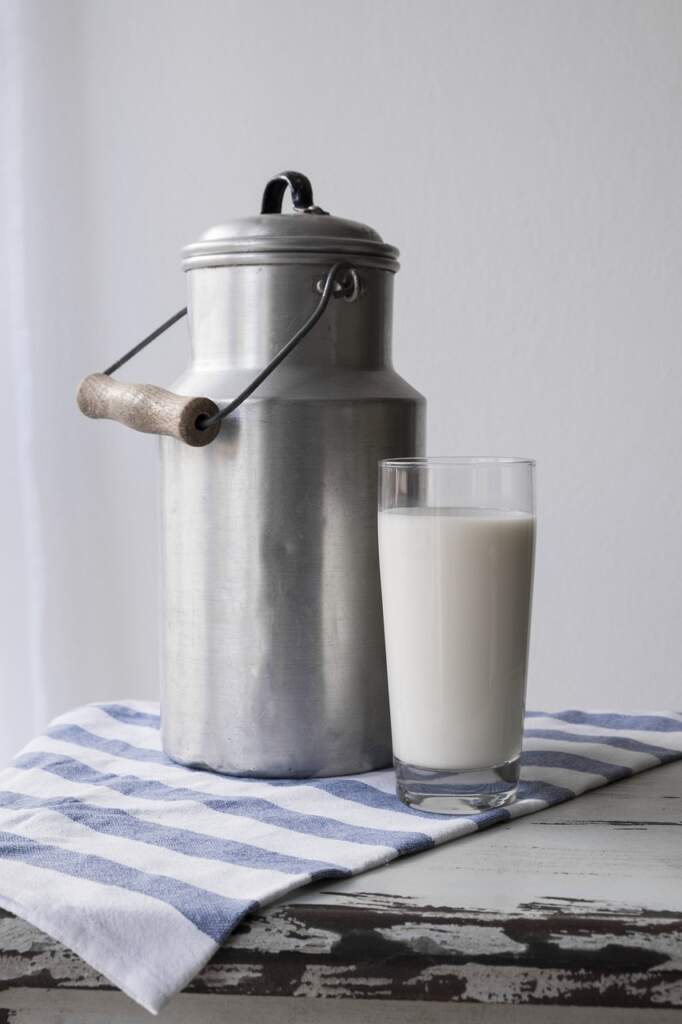If you’re looking for a sure fire way to sound crunchy, tell people that you drink raw milk. You might hear a “gasp!” or see a side eye here or there. But why has our culture made us fear what is actually nutritionally best for us? Let’s take a closer look into raw milk understand why it is better so we can convert some more raw milk drinkers! 🙂
The History of Raw Milk
In the 1800’s, people were falling sick to raw milk due to two main culprits: Brucellosis and Bovine Tuberculosis. This happened during the industrial revolution when people were moving into the cities. They moved their cows too and placed them in swill dairies. Conditions were crowded, filthy, and their cows were eating mush grains instead of lush grass they were used to. So, the cows became very sickly.
Sadly, people didn’t understand the necessity of sanitizing methods for milking or even medical care in those times. The cows grew sick and that sickness can be passed through it’s milk. Cows were not checked for these illnesses and therefore it would go undetected, causing people to get sick. The milk from these sick cows looked so bad they even added chalk to it for white coloring.
Other concerns were listeria, salmonella, E. Coli, and campylobacter which enter the milk through unsanitary conditions. The sick cows and filthy milking/living conditions created enough concern to start pasteurizing milk.
Pasteurizing milk involves taking cold milk, heating it to 161 degrees for 15 seconds between two stainless steel plates. Then, it is cooled back down to 39 degrees. Pasteurizing removes bacteria from the milk. Unfortunately, this process removes the most beneficial parts of milk.



Raw Milk Isn’t the Culprit
Prior to this time of the industrial revolution, people drank raw milk for centuries and never had issues. It’s very important to remember that cow’s milk is not inherently full of bacteria, as the main stream would have you think.
The issue wasn’t the milk. The issue was the sick cows and dirty conditions. Good education, knowledge, healthy cows, and sanitizing, results in perfectly safe raw milk. Had they focused on the conditions and making their cows healthy, (by treating the problem, not claiming that milk was the problem), we would be hearing a very different narrative. The nutrients/benefits of raw milk would be preached.
Benefits of Raw Milk
As mentioned above, raw milk contains so many health benefits. I have been amazed to learn about them. If you struggle with a dairy intolerance, chances are, you can drink raw milk! Pasteurization removes the enzymes that are in milk that allow your body to break it down. Dairy is now a top food allergen thanks to pasteurization. Wonderfully enough, raw milk has superior health advantages, and the enzymes are just one of them.
- Beneficial Enzymes
- Diverse Probiotics
- Bioavailable Phosphorus
- Healthy Fats
- IgA/IgG Immunoglobulins
- Bioavailable Vitamins
- Bioavailable Calcium
- Proteins
(It’s important to note that all of these are either destroyed, inhibited/damaged or made inactive when pasteurized. You’re basically drinking colored water.)
Studies have shown that children who drink raw milk have less allergies and higher pulmonary function. Also, there are fewer rates of eczema, asthma, allergies, ear infections, respiratory infections and fevers in those who drink raw milk. It is believed to help with the Regulatory T cells and benefit those who suffer with asthma.
Conclusion
If you’re hoping to find raw milk near you, try your famer’s market first. It will often be labeled, “not for human consumption.” As most states make it illegal to sell raw milk. You can also try this website- the raw milk finder. I have found that word of mouth is the best. Ask around at local farms, markets, and other crunchy networks.
I love to enjoy my raw milk frothed in my espresso in the mornings. Nothing better! So, if you have the option to try it, do! I remember being so hesitant, thinking it would be chunky or have a strange taste. But there is nothing chunky or gross about it. It truly tastes like milk should. I used to be on the bandwagon of coconut milk and almond milk. Then, I had a “what am I doing??” moment and remembered that REAL is always better. Real milk, real butter, real nutrients. Not fake, manufactured nutrition. Let’s help others not fear the real, but actually become knowledgeable.
As you’re venturing out with milk, check out our blog about nose to tail eating or tallow to learn the benefits of other parts of a cow!
